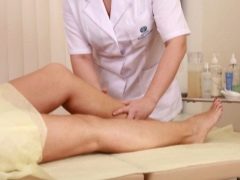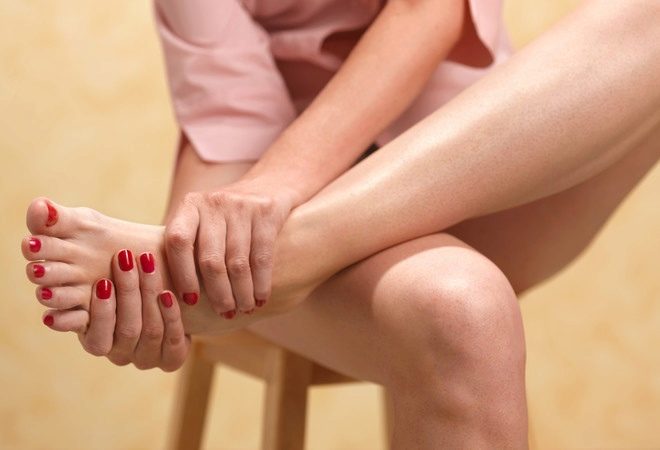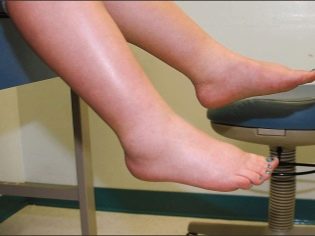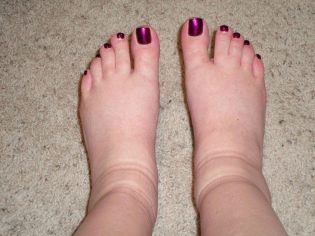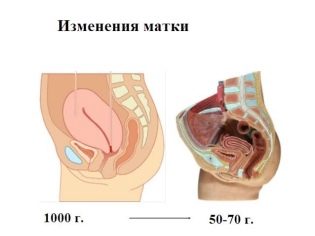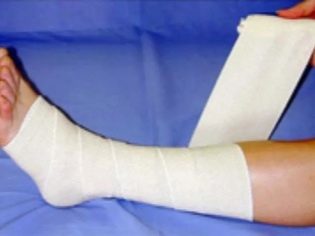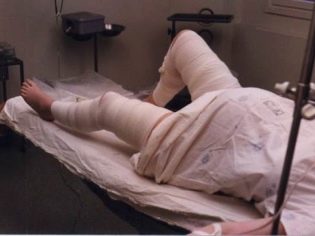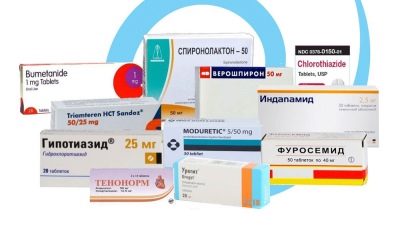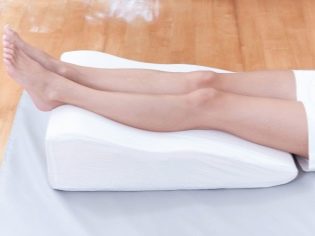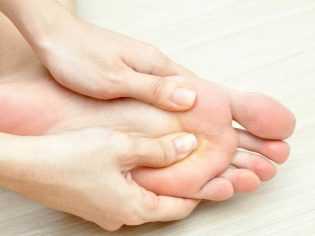Why legs swell after cesarean section and what to do?
The postoperative period and the recovery of a woman after a cesarean section require her strength and endurance. When the worst, it would seem, is already in the past, there may be some unpleasant symptoms, which, one way or another, are the result of surgical intervention.
In this article we will talk about why the legs can swell after cesarean section and what to do if this happens.
Signs of
Many women note that their legs swelled after a cesarean section in almost a few hours. Usually, leg edema is detected at the moment when a woman first tries to get out of bed 8-10 hours after surgery. Until that time, she is in a horizontal position, and simply does not pay attention to the ankles.
Edemas are manifested by an increase in the ankle and foot in size, when pressing on the skin with the fingers, there are bright spots that disappear after a few seconds.
Any edema is the accumulation of fluid in the tissues outside the vessels, in the extracellular space. Pregnant women know that in the last periods small edema of the legs can be considered a variant of the norm. The accumulation of fluid in the intercellular space occurs under the influence of pregnancy hormones, primarily under the action of progesterone.
Women whose labor was performed surgically may draw attention to the fact that postoperative swelling of the ankles and feet is stronger than it was during pregnancy. There is bewilderment, because the pregnancy itself is no longer there, why does the fluid accumulate in the wrong place?
The reasons
The most common cause of post-operative swelling of the legs is the large size of the uterus. After the operation, it became much easier, because the afterbirth was removed, the fetus, there is no weight of the amniotic fluid, but the size of the uterus decreases gradually. The process of involution of the reproductive organ is quite long, and finally the uterus takes on normal size only by 6-8 weeks after surgery.
After cesarean section, it resembles an empty big bag and still continues to press on the lower veins and lymph nodes in the inguinal zone. Thus, blood circulation in the lower limbs is disturbed, and lymph flow is disturbed. These edemas pass on their own as the uterus contracts. In the most severe case, the edema disappears by 10-12 days after the operative birth of the baby.
No less common reason that the legs after the operation swell, lies in the low mobility of women. The first 6-8 hours she lies almost motionless, and only then begins to try to roll over to the side, sit down, get up (after 10 hours from the moment of the operation). The longer a woman lies and is afraid to move, the stronger the swelling of the lower limbs can be.
In the supine position (and the puerperal resides in this very position), the lymph outflow is disturbed, the blood supply to the legs is poor. Therefore, doctors advise their patients still in the intensive care unit, when there is a way out of anesthesia, to begin to make circular movements with their feet clockwise and counterclockwise. This is an excellent prevention of swelling of the legs.
The cause of edema after surgical delivery may be preeclampsia, which the woman suffered during pregnancy.Changes occur smoothly and gradually, the kidneys can not be reconstructed to a new mode of operation immediately, so you need to be patient and follow all medical recommendations.
Edema can be a complication after the operation itself. Thrombosis of the lower extremities is sometimes manifested in this way. If the legs are swollen for the first time (this did not happen during pregnancy), then there is a reason to assume that it is a postoperative complication. In order to prevent it, it is recommended to bandage the legs with an elastic bandage before surgery in the maternity hospitals during a planned cesarean.
The reasons may lie in varicose veins, and in protein deficiency in a particular woman, if she is exhausted, malnourished while carrying a child (as an option, she followed a vegetarian diet).
In any case, the question of why the legs are swollen is best addressed to the attending physician on the morning or evening rounds. Analyzes that a woman after surgery gives almost every day will help to establish the true cause with greater accuracy. If required, treatment will be given to the woman.
Treatment
It should be noted that not all the causes that lead to edema of the legs after surgery need any special treatment. A moderate motor regimen, the use of contraction drugs, which are administered to a woman after cesarean section for faster involution of the uterus, help to quickly remove the swelling of the lower extremities.
The physiological edemas of pregnant women, which persist even after surgical delivery, pass by themselves as the progesterone concentration in the body decreases. When childbirth begins naturally, a drop in the level of this hormone invariably occurs several days before the onset of labor. If a woman was undergoing a planned caesarean section, progesterone will slowly decrease.
Breastfeeding will benefit. And to all participants in the process. The baby needs breast milk, stimulation of the nipples of the mammary glands during sucking causes the activation of oxytocin in the body of the newly-made mother. As a result, the uterus is reduced more actively, and swelling is also much faster.
Women should avoid all salty, pickled foods, spicy and fried. This implies a postoperative diet (a diet of a nursing mother). But even if a woman does not breastfeed a child, but suffers from lower extremity edema after surgical delivery, these products will still be considered forbidden to her.
If it is established that the edema has become a complication of the operation itself or a consequence of other disorders in the mother's mother’s body, which are also provoked by serious surgical intervention, the woman will be further examined and treated according to the type and type of the disorder.
Typically, such an examination is prescribed after the swelling does not subside within two weeks after surgery.
Diuretic preparations help to get rid of edema in these cases. They are prescribed simultaneously with vitamin preparations, so that nutrients are not removed from the body with urine in large quantities. Vitamins and minerals are very necessary for a woman in labor to have full breastfeeding, and for her own accelerated recovery.
Medicines will be prescribed that eliminate the underlying cause of the disease. Such treatment is prescribed by a doctor of narrow specialization. If the reason is in violations of the cardiovascular system, then it will be necessary to be treated under the control of a cardiologist, if it is a matter of varicose, the phlebologist will help, and for kidney diseases, the nephrologist will help.
To get rid of edema use numerous ointments, which are composed of heparin. With the expansion of the lower veins, venotonic preparations are prescribed - both locally (ointments, gels), and systemically (tablets, capsules).
Often, after surgery, women have thicker blood, and the number of platelets increases.This is due to the inevitable blood loss during cesarean section. If the patient is prone to impaired hemostasis, then she will need treatment with blood thinners, as well as a special diet and plenty of drinks.
Recommendations after discharge home
Edema is not a reason for extending the period of hospitalization; with them, after a cesarean, a woman and a child are discharged home on the fifth day, if there are no other complications. The first days of the house a woman just need to watch. If the edema does not subside within two weeks, you should contact the therapist in the place of residence, pass the tests to determine the true cause. In anticipation of relief new mother will help the following practical recommendations.
- Up to five times a day, lie down to rest with your legs elevated at an angle of 25 degrees. Use a pillow, a roller, a blanket rolled under a roll. Lay for 15-20 minutes.
- If you walk on your toes, swelling will decrease faster. Alternate the usual walking with walking on the toes, but do not strain the press. Roll from heel to toe.
- Wear a special compression garment (stockings). If such clothes are expensive for the family budget, bandage your feet, ankles and knees with an elastic bandage, but not too tight so as not to disturb the circulation of the limbs.
- Drink at least one and a half - two liters of fluid per day. Exclude carbonated drinks, alcohol. It is best to drink clean water without gas at room temperature (useful for lactation, and to relieve swelling of the lower extremities).
- Massage the ankles and feet at least twice a day.
- Do not sit in a pose in which one leg is thrown over the other.
Contrast foot baths, in which a woman alternately lowers her feet in warm and cold water, help to quickly get rid of edema. For trays, you can use sea salt, decoction of chamomile and calendula.
If the new mother feeds the baby, any treatment with medicines or folk remedies should be agreed with the pediatrician. It is necessary to take into account the ability of many pharmacological drugs to penetrate into breast milk, as well as similar properties of plants and alternative medicine.
If there is a need to take a medicine that is not compatible with breastfeeding, you should take a temporary break, transfer the baby to the mixture, and decant the breast milk and immediately dispose of it. Otherwise, its development will decline.
You can learn more about the causes of edema and how to get rid of them from the following video.
